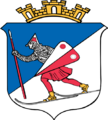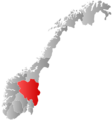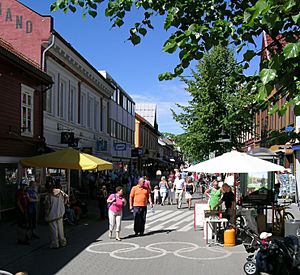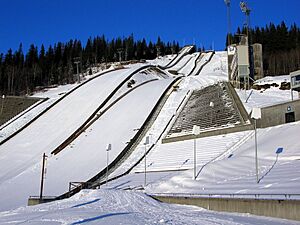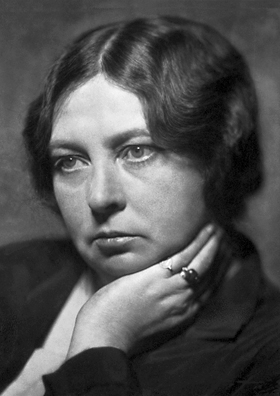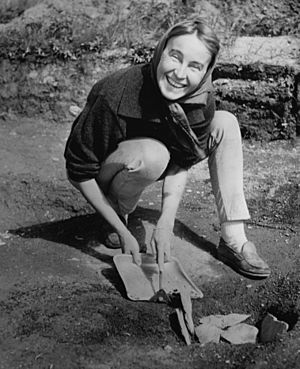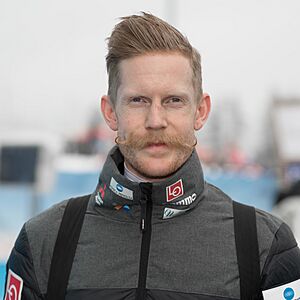Lillehammer facts for kids
Quick facts for kids
Lillehammer kommune
|
|||
|---|---|---|---|
|
Municipality
|
|||

View of the town of Lillehammer
|
|||
|
|||

Lillehammer within Innlandet
|
|||
| Country | Norway | ||
| County | Innlandet | ||
| District | Gudbrandsdal | ||
| Established | 1 Jan 1838 | ||
| Administrative centre | Lillehammer | ||
| Area | |||
| • Total | 477.95 km2 (184.54 sq mi) | ||
| • Land | 450.72 km2 (174.02 sq mi) | ||
| • Water | 27.23 km2 (10.51 sq mi) 5.7% | ||
| Area rank | #211 in Norway | ||
| Population
(2023)
|
|||
| • Total | 28,560 | ||
| • Rank | #39 in Norway | ||
| • Density | 63.4/km2 (164/sq mi) | ||
| • Change (10 years) | 6.4% | ||
| Demonym(s) | Lillehamring | ||
| Time zone | UTC+01:00 (CET) | ||
| • Summer (DST) | UTC+02:00 (CEST) | ||
| ISO 3166 code | NO-3405 | ||
| Official language form | Bokmål | ||
| Created as | Formannskapsdistrikt in 1838 | ||
|
|
|||
Lillehammer (Norwegian pronunciation: [ˈlɪ̂lːəˌhɑmːər]) is a municipality in Innlandet county, Norway. It is part of the traditional district of Gudbrandsdal. The main town and administrative center of the municipality is also called Lillehammer.
Some other important villages in the municipality include Fåberg, Hunderfossen, Jørstadmoen, Vingnes, and Vingrom. The municipality covers an area of about 478-square-kilometre (185 sq mi). This makes it the 211th largest municipality in Norway out of 356.
Lillehammer is also the 39th most populated municipality in Norway, with about 28,560 people living there. The number of people living in Lillehammer has grown by 6.4% over the last ten years.
The town of Lillehammer is the biggest urban area in the municipality. It is in the middle of the municipality, surrounded by countryside. The town center has many old wooden houses from the late 1800s. It is in a beautiful spot overlooking the northern part of Mjøsa lake and the Lågen river, with mountains all around. Lillehammer was proud to host the 1994 Winter Olympics and the 2016 Winter Youth Olympics.
Contents
- About Lillehammer Municipality
- Lillehammer's Past
- Learning in Lillehammer
- Lillehammer's Location and Nature
- Lillehammer's Economy
- Media in Lillehammer
- Getting Around Lillehammer
- Fun Places to Visit in Lillehammer
- Sports in Lillehammer
- Famous People from Lillehammer
- Lillehammer's Sister Cities
- See also
About Lillehammer Municipality
Lillehammer municipality was officially created on 1 January 1838. As the town grew, a small area from the nearby municipality of Fåberg was added to Lillehammer in 1906. Later, in 1964, the town of Lillehammer (with about 5,905 people) joined with Fåberg Municipality (with about 13,381 people) to form the larger Lillehammer Municipality we know today.
What's in a Name?
The name Lillehammer comes from an old farm called Hamar. The first Lillehammer Church was built there. The word Hamar means "stone" or "rocky hill." To tell it apart from the nearby town of Hamar, people started calling it "little Hamar," which became Lillehammer. In old stories, it was also known as "Little Trading Place."
Lillehammer's Coat of Arms
The coat of arms for Lillehammer was approved on 4 April 1898. It shows a birkebeiner (a person from a historical group of warriors) skiing down a mountain under a blue sky. The background above a diagonal line is blue, and below the line, it's white or silver. The birkebeiner is carrying a spear and a shield. This design is special because it reminds us of a famous historical event. During a civil war, the Birkebeiners carried the future King Haakon from Lillehammer to Rena on skis to keep him safe. This event is still celebrated today.
Churches in Lillehammer
The Church of Norway has several parishes, or local church areas, within Lillehammer municipality. These churches are part of the Diocese of Hamar.
| Parish | Church name | Location | Year built |
|---|---|---|---|
| Fåberg | Fåberg Church | Fåberg | 1727 |
| Lillehammer | Lillehammer Church | Lillehammer | 1882 |
| Nordre Ål | Nordre Ål Church | Lillehammer | 1994 |
| Nordseter | Nordseter Church | Nordseter | 1964 |
| Saksumdal | Saksumdal Church | Lillehammer | 1875 |
| Søre Ål | Søre Ål Church | Lillehammer | 1964 |
| Vingrom | Vingrom Church | Vingrom | 1908 |
Lillehammer's Past
The village of Lillehammer is located at the northern end of Norway's largest lake, Mjøsa. People have likely lived here since the Iron Age. The market here was mentioned in old stories as early as 1390. It was also a place where important meetings, called Thing assemblies, were held in 1390.
A famous story tells how in 1205, the Birkebeiner warriors Torstein Skjevla and Skjervald Skrukka met the King's son, Haakon, in Lillehammer. They then traveled on skis to Østerdalen to protect him. This event is still remembered and celebrated every March. The Lillehammer Church has been in this area since the Middle Ages.
Lillehammer was given special "market town rights" on 7 August 1827. At that time, only 50 people lived in the new town. This spot was chosen because it was along the Gudbrandsdalslågen river, which was a main travel route from the capital city to northern Norway. Within two years, the town's population grew to 360 people.
Better transport helped Lillehammer grow. A railway line from Christiania (now Oslo) to Eidsvoll was finished in 1852. From Eidsvoll, steamships traveled across Lake Mjøsa to Lillehammer. From there, new roads led further into the Gudbrandsdalen valley. This system made it easier to move timber and farm goods to the capital, which helped the town of Lillehammer become more important.
Lillehammer is well-known for hosting winter sports events. It was the host city for the 1994 Winter Olympics and the 2016 Winter Youth Olympics. It also tried to host events for the 2022 Winter Olympics with Oslo, but Oslo later withdrew its bid.
Lillehammer is home to the biggest literature festival in the Nordic countries. In 2017, it was named a UNESCO City of Literature because of its strong connection to books and writing.
Learning in Lillehammer
Lillehammer has many schools for students of all ages. Some of the primary and lower secondary schools include Hammartun Primary and Lower Secondary School, Søre Ål Primary School, and Kringsjå Primary and Lower Secondary School.
For older students, there is Lillehammer Upper Secondary School, which has two locations. The private high school Norwegian College of Elite Sports, known as NTG, also has a campus here. The Lillehammer campus of Inland Norway University of Applied Sciences is located just north of the town.
Lillehammer is also home to the Nansen Academy, which is an educational place for adults. It focuses on humanism and helps people from different backgrounds learn together.
In 1975, Lillehammer hosted the 14th World Scout Jamboree, a big international gathering of Scouts, from July 29 to August 7.
Lillehammer's Location and Nature
Lillehammer is located in the lower part of the Gudbrandsdal valley, at the northern end of Lake Mjøsa. It shares borders with several other municipalities: Øyer Municipality to the north, Gausdal Municipality to the northwest, Nordre Land Municipality to the southwest, Gjøvik Municipality to the south, and Ringsaker Municipality to the southeast. The mountain Nevelfjell is in the northeastern part of the municipality.
Lillehammer's Climate
Lillehammer has a climate with warm summers and cold, snowy winters. The Scandinavian mountains to the west and north help to keep the weather from being too influenced by the ocean. The highest temperature ever recorded was 34 °C (93 °F) in June 1970. The lowest temperature ever recorded was −31 °C (−24 °F) in December 1978 and January 1979. The average time without frost (when temperatures stay above freezing) is about 142 days a year.
| Climate data for Lillehammer 1991-2020 (240 m; extremes 1957 - 2018) | |||||||||||||
|---|---|---|---|---|---|---|---|---|---|---|---|---|---|
| Month | Jan | Feb | Mar | Apr | May | Jun | Jul | Aug | Sep | Oct | Nov | Dec | Year |
| Record high °C (°F) | 10.4 (50.7) |
12.5 (54.5) |
16.0 (60.8) |
23.4 (74.1) |
28.5 (83.3) |
34.0 (93.2) |
32.4 (90.3) |
33.0 (91.4) |
26.4 (79.5) |
19.5 (67.1) |
16.2 (61.2) |
11.3 (52.3) |
34.0 (93.2) |
| Mean daily maximum °C (°F) | −3.3 (26.1) |
−1.8 (28.8) |
3.7 (38.7) |
9.4 (48.9) |
15.4 (59.7) |
19.3 (66.7) |
21.7 (71.1) |
19.9 (67.8) |
14.9 (58.8) |
7.2 (45.0) |
1.2 (34.2) |
−2.8 (27.0) |
8.7 (47.7) |
| Daily mean °C (°F) | −6.1 (21.0) |
−5.4 (22.3) |
−1.2 (29.8) |
4 (39) |
9.4 (48.9) |
13.7 (56.7) |
16.1 (61.0) |
14.5 (58.1) |
10.1 (50.2) |
4.1 (39.4) |
−1.2 (29.8) |
−5.5 (22.1) |
4.4 (39.9) |
| Mean daily minimum °C (°F) | −8.4 (16.9) |
−8.1 (17.4) |
−4.6 (23.7) |
0 (32) |
4.5 (40.1) |
8.8 (47.8) |
11.4 (52.5) |
10.1 (50.2) |
6.4 (43.5) |
1.4 (34.5) |
−3.0 (26.6) |
−7.6 (18.3) |
0.9 (33.6) |
| Record low °C (°F) | −31.0 (−23.8) |
−29.5 (−21.1) |
−24.1 (−11.4) |
−14.0 (6.8) |
−5.4 (22.3) |
−2.2 (28.0) |
0.5 (32.9) |
−0.6 (30.9) |
−5.8 (21.6) |
−14.5 (5.9) |
−22.5 (−8.5) |
−31.0 (−23.8) |
−31.0 (−23.8) |
| Average precipitation mm (inches) | 52 (2.0) |
35 (1.4) |
35 (1.4) |
35 (1.4) |
64 (2.5) |
70 (2.8) |
80 (3.1) |
96 (3.8) |
65 (2.6) |
69 (2.7) |
69 (2.7) |
47 (1.9) |
717 (28.3) |
| Mean monthly sunshine hours | 28 | 68 | 126 | 168 | 212 | 242 | 237 | 195 | 136 | 83 | 44 | 18 | 1,557 |
Areas within Lillehammer
Lillehammer Municipality is divided into several smaller areas, including:
- Søre Ål
- Nordre Ål
- Lillehammer Centre
- Nybu
- Vårsetergrenda
- Røyslimoen
- Vingnes
- Jørstadmoen
- Fåberg
- Rudsbygd
- Saksumdal
- Vingrom
- Nordseter
- Hovemoen
- Busmoen
Lillehammer's Economy
Lillehammer's economy is based on its location. It is at the northern end of Lake Mjøsa and acts as a gateway to the Gudbrandsdal region. The main highway from Oslo to Trondheim also passes through here. The Mesna river used to power many small factories, but today Lillehammer has very little industry.
Media in Lillehammer
Getting Around Lillehammer
One of Norway's main train lines, the Dovre Line, goes through Lillehammer. It connects Hamar to the south with Trondheim in the north, running through the Gudbrandsdal valley. The major highway, European route E6, also passes through Lillehammer, making it easy to reach by car.
Fun Places to Visit in Lillehammer
Besides the Olympic sites, Lillehammer has many other interesting places for visitors:
- Maihaugen: This is Norway's largest open-air museum, located right in Lillehammer. It has 185 buildings, mostly from Lillehammer and the Gudbrandsdalen valley, showing how people used to live.
- Garmo Stave Church: An old wooden church built around 1150.
- The Norwegian Olympic Museum: This is the only museum in Northern Europe that tells the entire story of the Olympics, from ancient times to today. It also has a special section about the Lillehammer '94 Olympic Winter Games. You can find it inside the Maihaugen museum.
- Lillehammer Art Museum
- Hafjell: A ski resort about 15 km (9 mi) from Lillehammer. It hosted slalom and super-G events during the 1994 Olympics.
- Kvitfjell: Another ski resort about 55 km (34 mi) from Lillehammer, where the downhill skiing events of the 1994 Olympics took place.
- The PS Skibladner: This is the world's oldest paddle steamer that still runs on a regular schedule. It was launched in 1856. In summer, you can take a trip on it around Lake Mjøsa, stopping at places like Lillehammer, Moelv, Gjøvik, Hamar, and Eidsvoll.
- The ski jump at Lysgårdsbakkene: A famous landmark from the Olympics.
- Sjusjøen: A popular place for skiing with forests and mountains, located about 20 kilometres (12 miles) east of Lillehammer.
- The rock carvings at Drotten: Ancient carvings found near Fåberg.
- Mothership with Standing Matter: A sculpture by Antony Gormley in a special building designed by Snøhetta architects, close to Lillehammer Station.
Sports in Lillehammer
Lillehammer is a great place for sports, with many clubs:
- Lillehammer Ishockeyklubb: This ice hockey team plays in Norway's top league.
- Lillehammer Innabandy Klubb
- Lillehammer Orienteringsklubb
- Lillehammer Skiklubb
- Lillehammer Fotballklubb
- Lillehammer Frisbee
- Roterud Idrettslag
Famous People from Lillehammer
Many notable people have connections to Lillehammer:
Arts and Culture
- Kalle Løchen (1865–1893): A Norwegian painter and actor.
- Sigrid Undset (1882–1949): A famous novelist who won the Nobel Prize for Literature in 1928. She lived in Lillehammer for many years.
- Odd Grythe (1918–1995): A Norwegian radio and TV personality.
- Kjell Lund (1927–2013): A Norwegian architect, songwriter, and singer.
- Sveinung Hovensjø (born 1950): A Norwegian jazz musician.
- Kristin Sevaldsen (born 1966): A jazz musician, composer, and music producer.
- Atle Antonsen (born 1969): A Norwegian comedian and actor, born in Lillehammer.
- Ingrid Olava (born 1981): A Norwegian singer and musician, who grew up in Lillehammer.
Public Service and Innovation
- Lars Olsen Skrefsrud (1840–1910): A missionary in India.
- Johan Lunde (1866–1938): A theologian and bishop.
- Ulrik Frederik Lange (1808–1878): An educator and mayor of Lillehammer.
- Margit Haslund (1885–1963): A women's rights supporter and mayor of Lillehammer in 1940.
- Thor Bjørklund (1889–1975): An inventor who created the popular Ostehøvel, a cheese slicer.
- Anne Stine Ingstad (1918–1997): An archaeologist who discovered old Norse remains in Canada.
- Nils Slaatto (1922–2001): A well-known Norwegian architect.
- Bjørn Simensen (born 1947): A director of the Norwegian National Opera.
- Torkil Damhaug (born 1958): A Norwegian doctor and crime fiction writer.
Sports Stars
- Ove Nielsen (born 1924): A Danish rower who competed in the 1952 Summer Olympics.
- Petter Belsvik (born 1967): A football coach and former player.
- Jon Inge Høiland (born 1977): A former footballer who played for many clubs and for the Norwegian national team.
- Anita Rapp (born 1977): A footballer who won a gold medal at the 2000 Summer Olympics.
- Grete Eliassen (born 1986): An American-Norwegian freestyle skier.
- Edvald Boasson Hagen (born 1987): A Norwegian professional road racing cyclist.
- Robert Johansson (born 1990): A ski jumper who won two bronze and a team gold medal at the 2018 Winter Olympics.
- Robert Lee (born 2001): A ski jumper.
Lillehammer's Sister Cities
Lillehammer has special "sister city" agreements with these places:
Friendly Cities
Lillehammer also has friendly relationships with:
 Düsseldorf, Germany
Düsseldorf, Germany Minakami, Japan
Minakami, Japan Radviliškis, Lithuania
Radviliškis, Lithuania Sarajevo, Bosnia and Herzegovina
Sarajevo, Bosnia and Herzegovina
See also
 In Spanish: Lillehammer para niños
In Spanish: Lillehammer para niños


